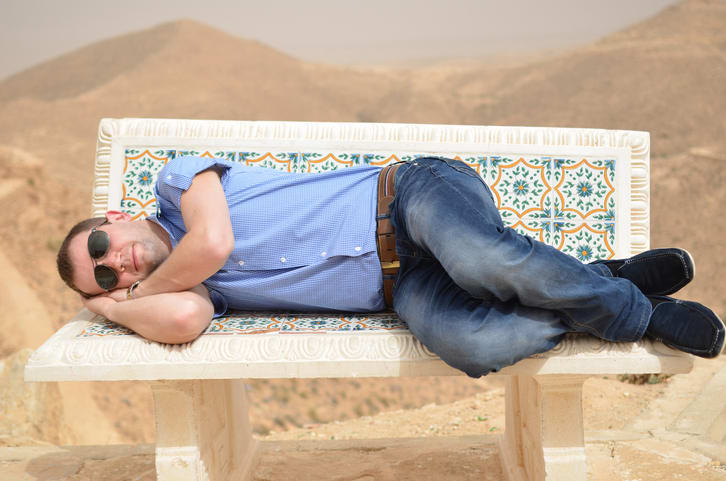I recently attended a family event over Shabbat in Bet El, in the Shomron. Bet El has over 1,000 families, and is surrounded by Arab areas such as Ramallah, Surda and Dura al Kar. The views are stunning.
On Shabbat morning, I found myself wondering whether this was truly the biblical site of Bet El, famed for Yaakov’s (Jacob’s) dream. I asked the people with whom we were staying.
“I’m not sure myself,” said our host. “But there’s a man who lives here who would definitely know. He’s a real authority on history and archaeology.”
“Who’s that?” I asked.
“Dr. Hagi Ben Artzi,” he replied. “He’s a professor of Talmud and Jewish Thought. By the way, he is Bibi Netanyahu’s brother-in-law. Sara Netanyahu is his sister.”
“Wow,” I said. “I’ve never met him, but I own one of his books!”
“No kidding! You can probably find him in the Bet Knesset Ha’Ashkenazi.”
I was very excited. Dr. Ben Artzi had written a book about the hidden miracles of the Six Day War, and I had based a performance about God’s miraculous intervention upon his book. I hadn’t counted on ever meeting him in person. I found him after shul, and introduced myself.
“Shalom, Hagi, my name is Shlomo Horwitz, and I’m visiting from Baltimore,” I said. “I’m a big fan of your book on Milchemet Sheshet HaYamim, and I even turned it into a play.”
“Shalom, Shlomo!” Hagi seemed delighted that someone had used his work for educational purposes. He welcomed me warmly to Bet El. We chatted briefly.
“Hagi, I was told you’d know whether this is the true biblical site of Bet El.”
Hagi smiled. “Technically, the area we are standing on is not. But the true Bet El is just up the hill from us. Would you like to see it?”
I was taken aback.
“Of course I would!”
“Well, I’m giving a tour to a high school group here for Shabbat, and we’re walking to the true Bet El at 3:00 PM. You are welcome as my guest, and you can feel free to bring others.”
I thanked him warmly, and showed up at the prearranged location at 3:00 PM, together with my wife, and my brother Avi. A group of high school seniors were waiting for Chagi as well. He arrived, and began the tour.
We walked on a road along the side of the yishuv, and the road began a steep incline toward a hilly area.
“We are about to see the very site that Yaakov Avinu had his dream, with the angels going up and down the ladder!” Hagi declared.
As we entered the site, we noticed that the road was lined with signs showing the verses from Genesis 28:10-18, discussing Yaakov’s dream, with angels going up and down the ladder.
“Here is the stone where Yaakov placed his head while he had the dream!” cried Hagai. He pointed to a rocky area that was a bit circular. “The fact that it’s rounded is borne out by Rashi’s interpretation that Yaakov had originally taken twelve stones to protect himself from wild animals, so it would therefore not be in a straight line. Of course, we have a tradition that the stones melded into one, based on the Torah changing the noun from ‘stones’ to ‘stone’.”
I recalled learning that the melding of the 12 stones was a metaphor representing the unity of the Jewish People – all different, yet united under God’s banner.
We all were transfixed by the large stone. But how did anyone really know…?
As if reading our minds, Hagi continued. “You might be asking yourselves, ‘how can anyone really know?’” He smiled.
“But tell me this – How do we know where Chevron is? How did we know where the Har Habayit was all these years? The answer is, we had a tradition. The Christians and Muslims also have traditions regarding various holy and historical sites in Israel. Often these traditions conflict, and it’s hard to know who’s right. But in this case, we have a Moslem tradition that this is the site, and you can see they built a Macca to mark the spot. A Macca is a stone structure formerly used for reflection and prayer.” Hagi pointed to the ruins of this structure.
“But the Christians had the exact same tradition, from even centuries earlier. This tells us that both traditions likely came from the Jews themselves. While this may not be conclusive to all, Professor Zev Vilnay, the noted geographer and Israel Prize recipient, felt certain that this is truly the site of Yaakov’s dream. And, if this is correct, this is also the site where Yaakov created Tefilat Arvit, the evening service still practiced today by Jews around the world.”
I wasn’t sure with 100% certainty that this was the true historical site, but Dr. Ben Artzi certainly made a case for it. Even if this wasn’t it, I imagined it couldn’t be far off. I looked around the windswept area, and could see thirty miles in every direction. The sun was beginning its descent on this lovely Shabbat afternoon, and I could see the tall buildings of Yerushalayim on the horizon. I tried to picture Yaakov Avinu drawing inspiration from his dream, and seeing the ladder as a representation of all of us; with our head planted in the heaven, steeped in God’s Inspiration, while our feet were firmly planted on the ground, the area of our earthly mission.
It was the stuff of dreams.
Shlomo Horwitz is the founding director of Jewish Crossroads, an educational theater project that has provided creative Torah programming across the US, Canada, England and Israel. He studied at Yeshivat Shaalvim and Yeshivat Ner Yisrael in Baltimore, where he received ordination from Rabbi Yaakov Weinberg. Shlomo is a CPA and a director of a consulting firm near Washington, DC. He can be reached through his site, www.jewishcrossroads.com.
The words of this author reflect his/her own opinions and do not necessarily represent the official position of the Orthodox Union.

